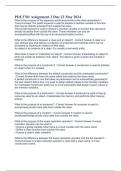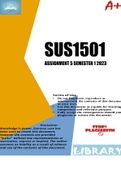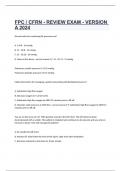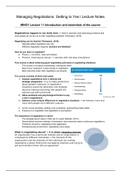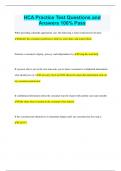Samenvatting boek
Chapter one
Dutch spatial planning is widely admired and is relevant outside of the Netherlands as well.
The book builds on the planning triangle, which is an theoretical framework that provides some
orientation within the discussion about spatial planning. The planning triangle consists of three key
elements: object of planning (what is planned), process of planning (who), and the context of
planning (how, where etc.). The book is showing how planning theories and planning practice are
intertwined and mirrors each other.
You can see planning as an mirror of society and its external developments like climate change,
socio-economic changes, demographic changes, crisis etc. namely, planning is always context specific
and needs to be understood in its socio-spatial context.
It is worth to mention that spatial planning is not the same as land use planning and zoning.
Planning can be considered as an public activity that is trying to influence the future distribution and
allocation of activity in space. These three elements are crucial to understand spatial planning: public
activity, future and space.
Future of planning: how further away the future, the more uncertainty there will be. One of the
tensions that is need to encountered is the tension between inevitable uncertainty and necessary
certainty. Certainty is necessary in planning because it provides stability. These certainty is in
contrast with strategic ambiguity: allows organisations to deny certain interpretations of their policy.
So they intentionally creating uncertainty to have a multi-interpretable policy.
To deal with the tension between inevitable uncertainty and necessary certainty spatial planning has
the objective to reduce uncertainty and make it manageable. There are some spatial planning tools
that can help planners to reach this objective. One of them is scenario planning. There are two types
of scenario planning, namely projective and prospective scenarios that deal with the future:
Projective scenarios: uses technique that is called forecasting. Projective scenarios are based
on the past and present, with the realization that the data is from the recent past. A time
span of a few months to a few years is normal.
Prospective scenarios: uses technique that is called back casting. They start with a vision of a
desirable future and derive steps to reach this desirable vision. These prospective scenarios
have a normative character that is based on certain values, norm and belief systems. A time
span of 30 years is not uncommon
Both types of scenarios are normative: projective scenarios can be manipulated by using different
data and prospective scenarios are more progressive in their normative character.
One effect that could appear when using scenarios is a time lag effect. A example of that is the real
estate collabs in 2010 as a consequence of the collabs of the bank Leham Brothers.
Systematic thinking about the future is an inherent part of spatial planning.
An important factor in deciding the desirable future is public interest. Public interest is dynamic and
constantly changing. Things like the corona crises have an massive impact on spatial planning. All
, these kind of challenges are continuously going on. This implies that planning is never finished.
Society and its interests are constantly changing: adaptation to a changing society is constantly
needed.
Another characteristic of spatial planning is that it is comprehensive and not sectoral. The main
object in planning is space and not territory. Sectoral planning involves only one specific branch of
policy, like environment or water management. Spatial planning is more comprehensive in a sense
that it is integral. This means that spatial planning need to the sectoral planning in to consideration
and coordinate them.
Planning is a public activity concerned with spatial development, but other private stakeholders and
sectors influences spatial development as well. For example real estate investors or engineering
companies. These are relevant for the economics of the state.
The definition of spatial planning according to the European compendium on spatial planning is: the
systematic preparation of policy making and the relevant action for implementing policy, aimed at
consciously intervening in spatial development, including the organization of these interventions in
order to preserve and improve spatial quality.
Policy cycle: heuristic model of policy making. Consists out of three steps:
1. Recognizing the problem
2. Proposal for a solution
3. Choice of solution (implementing policy)
One important question out of the book is how planning is positioned within state:
An important pillar of our democracy is the trias politica. Which is meant to prevent power abuse by
institutions. The trias politica exists out of three branches: the legislative, executive and judicative
branch. These three branches exists on all levels of state (national, regional and local).
1. Legislative: consists out of chosen politicians who are responsible for making law
2. Executive: implements and enforces law
3. Judicative: consists out of court and her organs.
Spatial planning is a part of the executive branch. They have to enforce and implement law which is
made by the legislative branch and is controlled by the judicative branch.
How can we see planning as a discipline?
Planning is analytical: planning has a substantial impact on peoples lives, it can make people
rich or poorer.
Planning intervenes: spatial planning as a discipline not only analyses what is happening but
also suggest what should be done in a certain spatial situation.
Planning is theoretical: there is not one planning theory but there are many theories from
different disciplines.
Planning is practical: because of the importance of context and location. Many planning
interventions are practical and not theoretical.
The three dimensions that structure the field of activity for the planner are the object, process and
context of planning. The fact that these three dimensions differ in every situation, makes that every
planning situations is unique.
Chapter one
Dutch spatial planning is widely admired and is relevant outside of the Netherlands as well.
The book builds on the planning triangle, which is an theoretical framework that provides some
orientation within the discussion about spatial planning. The planning triangle consists of three key
elements: object of planning (what is planned), process of planning (who), and the context of
planning (how, where etc.). The book is showing how planning theories and planning practice are
intertwined and mirrors each other.
You can see planning as an mirror of society and its external developments like climate change,
socio-economic changes, demographic changes, crisis etc. namely, planning is always context specific
and needs to be understood in its socio-spatial context.
It is worth to mention that spatial planning is not the same as land use planning and zoning.
Planning can be considered as an public activity that is trying to influence the future distribution and
allocation of activity in space. These three elements are crucial to understand spatial planning: public
activity, future and space.
Future of planning: how further away the future, the more uncertainty there will be. One of the
tensions that is need to encountered is the tension between inevitable uncertainty and necessary
certainty. Certainty is necessary in planning because it provides stability. These certainty is in
contrast with strategic ambiguity: allows organisations to deny certain interpretations of their policy.
So they intentionally creating uncertainty to have a multi-interpretable policy.
To deal with the tension between inevitable uncertainty and necessary certainty spatial planning has
the objective to reduce uncertainty and make it manageable. There are some spatial planning tools
that can help planners to reach this objective. One of them is scenario planning. There are two types
of scenario planning, namely projective and prospective scenarios that deal with the future:
Projective scenarios: uses technique that is called forecasting. Projective scenarios are based
on the past and present, with the realization that the data is from the recent past. A time
span of a few months to a few years is normal.
Prospective scenarios: uses technique that is called back casting. They start with a vision of a
desirable future and derive steps to reach this desirable vision. These prospective scenarios
have a normative character that is based on certain values, norm and belief systems. A time
span of 30 years is not uncommon
Both types of scenarios are normative: projective scenarios can be manipulated by using different
data and prospective scenarios are more progressive in their normative character.
One effect that could appear when using scenarios is a time lag effect. A example of that is the real
estate collabs in 2010 as a consequence of the collabs of the bank Leham Brothers.
Systematic thinking about the future is an inherent part of spatial planning.
An important factor in deciding the desirable future is public interest. Public interest is dynamic and
constantly changing. Things like the corona crises have an massive impact on spatial planning. All
, these kind of challenges are continuously going on. This implies that planning is never finished.
Society and its interests are constantly changing: adaptation to a changing society is constantly
needed.
Another characteristic of spatial planning is that it is comprehensive and not sectoral. The main
object in planning is space and not territory. Sectoral planning involves only one specific branch of
policy, like environment or water management. Spatial planning is more comprehensive in a sense
that it is integral. This means that spatial planning need to the sectoral planning in to consideration
and coordinate them.
Planning is a public activity concerned with spatial development, but other private stakeholders and
sectors influences spatial development as well. For example real estate investors or engineering
companies. These are relevant for the economics of the state.
The definition of spatial planning according to the European compendium on spatial planning is: the
systematic preparation of policy making and the relevant action for implementing policy, aimed at
consciously intervening in spatial development, including the organization of these interventions in
order to preserve and improve spatial quality.
Policy cycle: heuristic model of policy making. Consists out of three steps:
1. Recognizing the problem
2. Proposal for a solution
3. Choice of solution (implementing policy)
One important question out of the book is how planning is positioned within state:
An important pillar of our democracy is the trias politica. Which is meant to prevent power abuse by
institutions. The trias politica exists out of three branches: the legislative, executive and judicative
branch. These three branches exists on all levels of state (national, regional and local).
1. Legislative: consists out of chosen politicians who are responsible for making law
2. Executive: implements and enforces law
3. Judicative: consists out of court and her organs.
Spatial planning is a part of the executive branch. They have to enforce and implement law which is
made by the legislative branch and is controlled by the judicative branch.
How can we see planning as a discipline?
Planning is analytical: planning has a substantial impact on peoples lives, it can make people
rich or poorer.
Planning intervenes: spatial planning as a discipline not only analyses what is happening but
also suggest what should be done in a certain spatial situation.
Planning is theoretical: there is not one planning theory but there are many theories from
different disciplines.
Planning is practical: because of the importance of context and location. Many planning
interventions are practical and not theoretical.
The three dimensions that structure the field of activity for the planner are the object, process and
context of planning. The fact that these three dimensions differ in every situation, makes that every
planning situations is unique.

